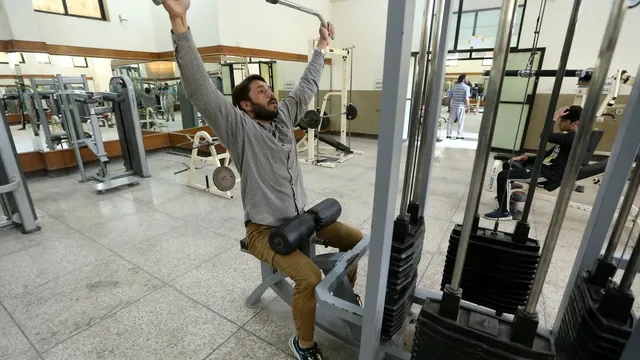Longer figures, smaller skulls, darker skin... What if climate change affects human appearance? As the planet heats up rapidly, our bodies may be changed by rising temperatures.
Climate change is having an impact on human morphology, but it all depends on which populations we are talking about and how much warming we are talking about," said Alain Fromin, an anthropologist and biologist at the Muséum national d'histoire naturelle (France's national museum of natural history).
Is it an extra 1°C, 4°C or 10°C? It is not the same," he added.
Human evolution is guided by the principle of natural selection, according to which the environment influences the appearance of living things so that they adapt to their environment.
Climate is the basis for the evolution of human appearance.
This theory is known as the radiator theory. Depending on the region of the world and the hot or cold climate, typical morphologies emerge.
"The Inuit have a reason for having a body close to an orb, with a large body mass and short limbs, because that is where heat is easily lost," analyzed Alain Fromin, who pointed out that these northern peoples have short legs and arms as well as a large chest to limit exchanges with the outside world.
"This is also true in the opposite direction - in very hot regions such as East Africa, the morphology is long and slender," he added.
The explanation is simple. Body mass - which generates heat - is lower when the climate necessitates cooling the body. Similarly, people living in countries with high temperatures tend to be tall, with a large body surface area. This is called evapotranspiration," explained Alain Fromin.
All human beings have sweat glands that secrete fluid [sweat] to cool the body, but they are more necessary in hot climates. So the greater the body surface area, the more effective the sweating! While science has proven that indeed the environment has influenced the physical appearance of people around the world, particularly their size, this evolution has taken thousands if not millions of years.
"In prehistoric times, human beings lived naked, so they were directly exposed to the environment. Today, we have many technical solutions that buffer the climate," Frohmen clarified.
"Environmental variables such as temperature, amount of sunlight or rainfall, and humidity directly affect some of our phenotypes [observable physical traits]. This affects skin pigmentation, hair shape, etc.," added Louis Quintana-Mursi, a population geneticist and professor at the Collège de France and Institut Pasteur.
Skin colour, for example, differs in different regions of the world. Light skin color coincides with regions where ultraviolet (UV) rays are insufficient for vitamin D synthesis by the epidermis, while dark skin is useful in hot climates for protection from strong UV rays.
Facial features, such as the nose, also adapt to the surrounding climate.
Africans have wider noses, especially in equatorial zones, because they breathe warm and humid air that is not aggressive to the lungs," Alain Fromin pointed out.
On the other hand, in drier and colder climates such as Europe, the nose is narrower and longer so that the air inhaled is in direct contact with the internal mucous membranes. It is thus humidified or warmed directly so as not to irritate the bronchi.
Is global warming a catalyst for morphological adaptation?
The question now relates to the effect of rising temperatures on human appearance. Are the physical changes that have occurred over thousands of years accelerating?
Is global warming modifying existing phenotypes? What is certain is that the predicted scenarios favor heat-adapted morphology.
"Our ancestors originally had to adapt to a colder climate after migrating from Africa to Europe. We can imagine that in the future, the opposite phenomenon will occur," argues Laura Segurel, a researcher in genetic anthropology at the CNRS, in an article in Figaro published in August 2023.
This trend can already be observed in animals. Numerous studies highlight the physical adaptations of fauna to rising temperatures.
Birds have larger beaks, foxes larger ears and magpies longer tails - all to regulate their internal temperature. These are all changes that can be found in many species around the world, and that occur in a much shorter period of time than usual, compared to previous morphological changes that lasted thousands of years.
An example is the American rabbit (Lepus americanus). While its brown coat turns white in winter to camouflage itself in the snow, the animal increasingly retains its dark coat throughout the year in the absence of snowflakes, revealed an international study published in the journal Science in February 2018.
This is also the case for other species, such as Arctic foxes and snow partridges (rock ptarmigan). In the case of Australian night parrots, on the other hand, the surface area of their beaks has increased by between 4 and 10% since 1871, i.e. over a period of a century and a half.
Intense global warming could lead to changes in human morphology - taller and thinner figures, wider noses and smaller skulls. However, relying on genetic evolution to cool bodies is pointless.
Human beings are already capable of adapting culturally to avoid heat waves.
In prehistoric times, humans lived naked, so they were directly exposed to the environment - argues Alain Fromin.
Today, we have many technical solutions that provide a buffer against the climate: clothes, housing, air conditioning, etc."
For the author of the book Anatomie impertinente - Le corps humain et l'évolution (April 2013), these mediators would save us a profound physical transformation.
"What matters is the actual temperature to which the body is subjected. If you are constantly in an air-conditioned environment, you can live in the tropics without any problem!" said the specialist.
Furthermore, while morphological adaptation would take thousands of years, migration is an immediate solution. The most coherent hypothesis would be a mass exodus from regions that have become uninhabitable due to heat.
"Climate change does not necessarily require people to stay put and adapt. They can also move," stressed Alain Fromin.
What will this look like in the medium and long term?
If there are any physical changes, they will be very limited and take thousands of years.
"Bacteria and insects are likely to adapt much faster to climate change than humans," says Laura Segurel, who pointed out that genetic changes in humans are slower.
Moreover, the scenarios predicted by scientists remain measurable for now.
An extra 4°C would not change the appearance of Europeans," said Alain Fromin.
"It would require a radical change in temperatures. But we do not expect a rise of 10°C or more. So I don't think there will be any major change in the appearance of people, even in the long term," he added.
The anthropologist pointed out that it is impossible to predict the planet's climate and that there is no certainty of a spectacular global warming.
"British climatologist Friederike Otto insisted: 'Heatwaves are not evidence of "runaway warming" or "climate collapse".
Alain Fromin added: 'We are in an interglacial phase and heading for an ice age in a few thousand years. By the time the biological adaptations occur, a lot will have changed."
However, global warming could disrupt this cycle and prevent the Earth from entering an ice age. And thus increase the likelihood of a transformation in human morphology.
In addition to taller and thinner bodies, there may also be less body fat, as this thickness prevents efficient heat elimination. Meanwhile, skin diseases may become more severe as the skin microbiome is affected by climatic parameters. More acne and eczema would be a consequence of warmer temperatures.
On the other hand, there is no risk of discoloration of human skin. Even if the climate gets warmer, we should not be exposed to more UV rays, so the skin colour should not change," explained Alain Fromin.
On the other hand, if populations migrate to colder areas, they could eventually lose melanin and have lighter skin."
This would also take thousands of years and could easily be circumvented through technological innovation. | BGNES
---
Analysis by Juliette Baeza for Slate Portal.
Global warming could affect our appearance

BGNES
While climate is the basis of different human morphologies, how and when will our bodies be changed by global temperature rise?


 Breaking news
Breaking news
 Europe
Europe
 Bulgaria
Bulgaria





